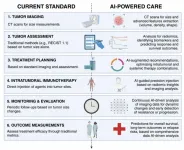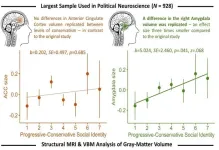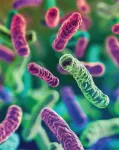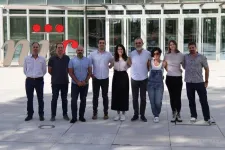(Press-News.org)
For more than 100 years, scientists have been using X-ray crystallography to determine the structure of crystalline materials such as metals, rocks, and ceramics.
This technique works best when the crystal is intact, but in many cases, scientists have only a powdered version of the material, which contains random fragments of the crystal. This makes it more challenging to piece together the overall structure.
MIT chemists have now come up with a new generative AI model that can make it much easier to determine the structures of these powdered crystals. The prediction model could help researchers characterize materials for use in batteries, magnets, and many other applications.
“Structure is the first thing that you need to know for any material. It's important for superconductivity, it's important for magnets, it's important for knowing what photovoltaic you created. It's important for any application that you can think of which is materials-centric,” says Danna Freedman, the Frederick George Keyes Professor of Chemistry at MIT.
Freedman and Jure Leskovec, a professor of computer science at Stanford University, are the senior authors of the new study, which appears in the Journal of the American Chemical Society. MIT graduate student Eric Riesel and Yale University undergraduate Tsach Mackey are the lead authors of the paper.
Distinctive patterns
Crystalline materials, which include metals and most other inorganic solid materials, are made of lattices that consist of many identical, repeating units. These units can be thought of as “boxes” with a distinctive shape and size, with atoms arranged precisely within them.
When X-rays are beamed at these lattices, they diffract off atoms with different angles and intensities, revealing information about the positions of the atoms and the bonds between them. Since the early 1900s, this technique has been used to analyze materials, including biological molecules that have a crystalline structure, such as DNA and some proteins.
For materials that exist only as a powdered crystal, solving these structures becomes much more difficult because the fragments don’t carry the full 3D structure of the original crystal.
“The precise lattice still exists, because what we call a powder is really a collection of microcrystals. So, you have the same lattice as a large crystal, but they’re in a fully randomized orientation,” Freedman says.
For thousands of these materials, X-ray diffraction patterns exist but remain unsolved. To try to crack the structures of these materials, Freedman and her colleagues trained a machine-learning model on data from a database called the Materials Project, which contains more than 150,000 materials. First, they fed tens of thousands of these materials into an existing model that can simulate what the X-ray diffraction patterns would look like. Then, they used those patterns to train their AI model, which they call Crystalyze, to predict structures based on the X-ray patterns.
The model breaks the process of predicting structures into several subtasks. First, it determines the size and shape of the lattice “box” and which atoms will go into it. Then, it predicts the arrangement of atoms within the box. For each diffraction pattern, the model generates several possible structures, which can be tested by feeding the structures into a model that determines diffraction patterns for a given structure.
“Our model is generative AI, meaning that it generates something that it hasn't seen before, and that allows us to generate several different guesses,” Riesel says. “We can make a hundred guesses, and then we can predict what the powder pattern should look like for our guesses. And then if the input looks exactly like the output, then we know we got it right.”
Solving unknown structures
The researchers tested the model on several thousand simulated diffraction patterns from the Materials Project. They also tested it on more than 100 experimental diffraction patterns from the RRUFF database, which contains powdered X-ray diffraction data for nearly 14,000 natural crystalline minerals, that they had held out of the training data. On these data, the model was accurate about 67 percent of the time. Then, they began testing the model on diffraction patterns that hadn’t been solved before. This data came from the Powder Diffraction File, which contains diffraction data for more than 400,000 solved and unsolved materials.
Using their model, the researchers came up with structures for more than 100 of these previously unsolved patterns. They also used their model to discover structures for three materials that Freedman’s lab created by forcing elements that do not react at atmospheric pressure to form compounds under high pressure. This approach can be used to generate new materials that have radically different crystal structures and physical properties, even though their chemical composition is the same.
Graphite and diamond — both made of pure carbon — are examples of such materials. The materials that Freedman has developed, which each contain bismuth and one other element, could be useful in the design of new materials for permanent magnets.
“We found a lot of new materials from existing data, and most importantly, solved three unknown structures from our lab that comprise the first new binary phases of those combinations of elements,” Freedman says.
Being able to determine the structures of powdered crystalline materials could help researchers working in nearly any materials-related field, according to the MIT team, which has posted a web interface for the model at crystalyze.org.
The research was funded by the U.S. Department of Energy and the National Science Foundation.
###
Written by Anne Trafton, MIT News
END
HOUSTON ― The University of Texas MD Anderson Cancer Center’s Research Highlights showcases the latest breakthroughs in cancer care, research and prevention. These advances are made possible through seamless collaboration between MD Anderson’s world-leading clinicians and scientists, bringing discoveries from the lab to the clinic and back.
Genetic factors underscore disparities in colorectal cancer survival
Patients with colorectal cancer have varied overall survival, but it remains unclear how the frequency of certain gene mutations among different racial and ethnic groups influences outcomes. To investigate, researchers led by John Paul Shen, M.D., and ...
“We explore how integrating these technologies could revolutionize personalized oncology.”
BUFFALO, NY- September 19, 2024 – A new editorial was published in Oncotarget's Volume 15 on September 17, 2024, entitled, “The emerging role of AI in enhancing intratumoral immunotherapy care.”
As highlighted in the abstract of this editorial, the emergence of immunotherapy (IO), and more recently, intratumoral IO, offers a novel approach to cancer treatment. This method enhances immune responses, allows for combination therapies, and helps reduce systemic adverse events. These techniques aim to ...
Conservative voters have slightly larger amygdalas than progressive voters—by about the size of a sesame seed. In a replication study publishing September 19 in the Cell Press journal iScience, researchers revisited the idea that progressive and conservative voters have identifiable differences in brain morphology, but with a 10x larger and more diverse sample size than the original study. Their results confirmed that the size of a person’s amygdala is associated with their political views but failed to find a consistent association between politics and the anterior cingulate cortex (ACC). Anatomical differences in both ...
A new international collaborative study provides a list of the wildlife species present at the market from which SARS-CoV-2, the virus responsible for the COVID-19 pandemic, most likely arose in late 2019. The study is based on a new analysis of metatranscriptomic data released by the Chinese Center for Disease Control and Prevention (CDC). The data come from more than 800 samples collected in and around the Huanan Seafood Wholesale market beginning on January 1, 2020, and from viral genomes reported from early COVID-19 patients. The research appears September 19 in the journal Cell.
“This is one of the most ...
Human breast milk regulates a baby’s mix of microbes, or microbiome, during the infant’s first year of life. This in turn lowers the child’s risk of developing asthma, a new study shows.
Led by researchers at NYU Langone Health and the University of Manitoba, the study results showed that breastfeeding beyond three months supports the gradual maturation of the microbiome in the infant’s digestive system and nasal cavity, the upper part of the respiratory tract. Conversely, stopping breastfeeding earlier than three months disrupts the paced development of the microbiome and ...
The GENOXPHOS (Functional Genetics of the Oxidative Phosphorylation System) group at the Centro Nacional de Investigaciones Cardiovasculares (CNIC) has discovered a crucial role of sodium in the generation of cellular energy. The study, led by GENOPHOS group leader Dr. José Antonio Enríquez, also involved the participation of scientists from the Complutense University of Madrid, the Biomedical Research Institute at Hospital Doce de Octubre, the David Geffen School of Medicine at UCLA, and the Spanish research networks on frailty and healthy aging (CIBERFES) ...
Researchers at Cranfield University have developed an innovative new method for identifying biomarkers in wastewater using origami-paper sensors, enabling the tracking of infectious diseases using the camera in a mobile phone. The new test device is low-cost and fast and could dramatically change how public health measures are directed in any future pandemics.
Wastewater a key way to track infections
Testing wastewater is one of the primary ways to assess the prevalence of infectious diseases in populations. Researchers take samples from various ...
About The Study: In this large cohort study of successive pregnancies, influenza vaccination was not associated with increased risk of adverse perinatal outcomes, irrespective of interpregnancy interval and vaccine type. Findings support recommendations to vaccinate pregnant people or those who might be pregnant during the influenza season.
Corresponding Author: To contact the corresponding author, Darios Getahun, MD, PhD, MPH, email darios.t.getahun@kp.org.
To access the embargoed study: Visit our For The Media website at this link https://media.jamanetwork.com/
(doi:10.1001/jamanetworkopen.2024.34857)
Editor’s ...
About The Study: The findings of this study suggest that optimizing body mass index (BMI) in women and men from the preconception period onward might be an important strategy to improve fertility and reduce the risk of miscarriage.
Corresponding Author: To contact the corresponding author, Vincent W. V. Jaddoe, MD, PhD, email v.jaddoe@erasmusmc.nl.
To access the embargoed study: Visit our For The Media website at this link https://media.jamanetwork.com/
(doi:10.1001/jamanetworkopen.2024.36157)
Editor’s Note: Please see the article for additional information, including other authors, author contributions and affiliations, conflict ...
A new international study provides a shortlist of the wildlife species present at the market from which SARS-CoV-2, the virus responsible for the COVID-19 pandemic, most likely arose in late 2019.
The study, published Thursday in the journal Cell, is based on an analysis of genetic data released by the Chinese Center for Disease Control and Prevention. The data comes from more than 800 samples collected in and around the Huanan Seafood Wholesale market in Wuhan, China, beginning on Jan. 1, 2020, and from viral genomes from early COVID-19 patients.
"This may be the last big, new set of data directly from ...





